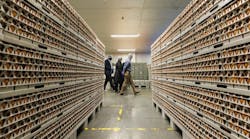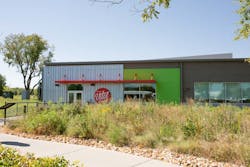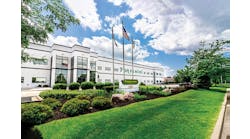One of the first things you notice when you arrive at Vital Farms’ egg washing and packaging facility in Springfield, Mo., is the landscaping – or lack thereof.
It's part of Vital Farms’ overall commitment to sustainability, which is why the facility — known as the Egg Central Station (ECS) – is Food Processing’s Green Plant of the Year.
A certified B Corporation, Vital Farms contracts only with farmers who furnish pasture-raised eggs, from hens treated humanely on farms that practice sustainable agriculture. Shell eggs are its main product: others include butter, hard-boiled eggs, ghee and liquid whole eggs.
The company’s focus on sustainability influenced many decisions when it came both to building the plant and expanding it. It opened in 2017, and an addition this year doubled the facility’s size to its current 150,000 sq. ft.
The Springfield facility processes about 6 million eggs a day, sending them off to distribution centers and other locations that feed some 21,500 retail stores. The eggs are all packaged in recyclable retail egg cartons, mostly 12-count, under the Vital Farms brand, or packaged in bulk boxes for hundreds of foodservice operators across the country.
Another big factor is automation. The facility’s 200 or so employees touch the eggs as little as possible; the unpacking, packing and other handling is done by robots.
Cave storage
The eggs come in on special pallets, from Springfield Underground, a cold storage facility across town that’s literally cut like a cave into a mountain. That setup enables Vital Farms’ eggs to be cooled with minimal energy – 25% less than usual, by the company’s estimate.
The eggs are unpacked robotically onto a conveyor belt with indentations, and are carried into the washing room, also known as the engine room. As they travel through, they are scrubbed with brushes and 100°F water.
The washing room is home to several sustainable features. One challenge is that the process leaves the air hot and humid. If that air were allowed to dissipate, as in many egg plants, it would make the rest of the plant that much more uncomfortable and force the HVAC system to do extra work. The Springfield plant keeps the air from the washing room contained and vents it only outside.
A bigger challenge is what to do with the high volumes of water that it takes to wash the eggs. Vital Farms minimizes water use by capturing and reusing the wash water, after filtering it to remove solids. Microbial contamination is not an issue, due to the water’s heat and the cleaning chemicals. Vital Farms follows USDA regulations that say the water has to be thrown out after four hours of use; if not for that, the water could probably be used significantly longer, Kicklighter says.
The eggs then pass into a drying/packaging room, also set up to ensure outside venting of humid air. They’re dried by a forced air stream and run over a checkweigher, which grades them by weight into one of the standard USDA grades (small, medium, large, extra-large, jumbo) and shunts them onto one of 22 packaging lines. There they get robotically packaged into 6-, 12- or 18-count cartons, which are then automatically case-packed and palletized.
The plant also deals with waste as efficiently as possible. Eggs too small or too large to be sold at retail get shipped to a co-manufacturer for processing into boiled or liquid eggs; other waste is routed to pet food manufacturers.
Green from the get-go
The original plant was built with green principles in mind, Kicklighter says. It had LED lights throughout and blinds directed by sensors that get raised or lowered depending on how much sunlight is coming through. These were augmented with outdoor free-standing solar panels, which feed electricity into the local power grid.
“When we added the expansion, when we stepped back and looked at [the plant] currently, it was really ahead of its time, especially for this area,” Kicklighter says. “There were a lot of features that you will not see anywhere in Springfield or throughout most of the country.”
It's always a challenge to add green features to an existing building, says Victor Diez-Canseco, principal at Sandpebble South Inc., the builder that Vital Farms used for the project. It’s even tougher when the plant can’t shut down.
“Without question, the biggest challenge was adding onto and integrating the building systems of the expansion of ECS while the original plant was in full operation,” Diez-Canseco says. “I like the analogy of doing open heart surgery on a patient while they are playing tennis.”
One of the most prominent new green features is water retention. As part of the natural landscaping, Vital Farms installed several retention ponds throughout the facility, which are capable of handling 700,000 pounds of rainwater. The ponds’ function is to retain and slowly release the rainwater that runs off the facility’s roof and parking lot, recharging local aquifers without overwhelming the ground and causing drainage problems. The system is designed to capture the maximum amount of rainwater, with some of the ponds close enough to the building to catch it directly from the roof.
The conventional wisdom about landscaping is that you want little of it close to a processing facility, so that it doesn’t become a staging ground for insects or other pests. Kicklighter doesn’t see it that way.
“Typically, when you hear about landscape features close to a facility that drives pests in, I think you have to look at it a little more holistically,” he says. Pests typically enter a building because they find no shelter or sustenance in the concrete and asphalt that surround it. With natural landscaping, they’re feeding and sheltering where they have for years, and have no motivation to get into the building.
As Kicklighter is fond of saying: “If you were to take the building out, you would never know the facility ever existed there.”




